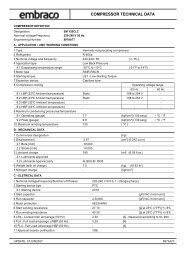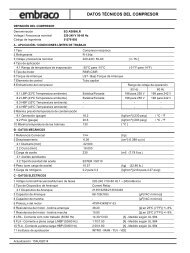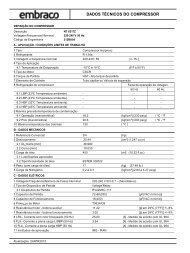Compressor Handbook - Embraco
Compressor Handbook - Embraco
Compressor Handbook - Embraco
You also want an ePaper? Increase the reach of your titles
YUMPU automatically turns print PDFs into web optimized ePapers that Google loves.
6.4.5 Guide for the use of R290<br />
6.4.5.1 General information<br />
COMPRESSORS<br />
HANDBOOK<br />
Chapter<br />
INFORMATION ABOUT CORRECT COMPRESSOR INSTALLATION<br />
The refrigerant R290 (propane) is used to substitute R22, as well as R404A, for low and medium<br />
back pressure applications, and air conditioning.<br />
Before supplying compressors for use with R290, it is first necessary to perform an evaluation<br />
of the risks involved with the use of this refrigerant. The customer should perform a risk assessment<br />
to ensure proper knowledge about the handling and use of the R290 in the refrigerant system<br />
(for further information please contact the Technical Assistant Department at <strong>Embraco</strong><br />
Europe).<br />
Refrigerant R290 can normally be used in the same compressor designed for use with R22, but<br />
with a different (hermetic type) thermal overload protector.<br />
Tabella 29 R290 Physical Characteristics<br />
Molecular Weight 44.1 kg / kmole (Ref.: R 22 = 86.5)<br />
Critical Temperature 96.8 °C (Ref.: R 22 = 96.1 °C)<br />
Critical Pressure 42.5 bar (Ref.: R 22 = 49.8 bar)<br />
Boiling Point -42.1 °C (Ref.: R 22 = -40.8 °C)<br />
Flammability in Air<br />
Minimum limit. LEL = 2.1% in vol.;<br />
Maximum limit UEL = 9.5% in vol.<br />
Table 30 R290 Ecological Characteristics<br />
ODP (Ozone Depletion Potential) 0 (Ref.: R 22 = 0.05)<br />
GWP (Global Warming Potential) 3 (100 years) (Ref.: R 22 = 1700)<br />
PLEASE NOTE: R290 is flammable and should then be handled by qualified personnel in accordance<br />
with the rules and regulations now established for safe use.<br />
6.4.5.2 System component compatibility<br />
All of the components in the refrigeration system that may contain contaminants should conform<br />
to the requirements outlined in norm DIN 8964 (1) .<br />
The presence of the contaminants paraffin and silicon is not permitted.<br />
6.4.5.3 Expansion device<br />
For a new application the first component to be dimensioned should be the capillary tube. To prepare<br />
the prototype, use chapter 6.6 - CAPILLARY TUBES as a reference.<br />
Generally, when changing a system from R22 to R290, the same capillary tube can be used although<br />
the length should be decreased by approximately 5%.<br />
It is not recommended to use a capillary tube with an internal diameter less than 0.6 mm.<br />
For each system the optimal dimensioning of the capillary tube should be performed in an appropriate<br />
test laboratory, in order to obtain the best working conditions.<br />
6.4.5.4 Evaporator and condenser<br />
Generally to convert a system from R22 to R290, the same evaporator and condenser may be used.<br />
(1) The soluble residual contents and solid residues must be less than 100mg /m 2 of system internal surface area. Of this, a<br />
maximum of 40 mg/m 2 can be soluble and the maximum of 60mg /m 2 can be insoluble (for the definitions of solid/soluble<br />
and additional details refer to the norm mentioned above).<br />
Doc. Code Emission Revision Date Page<br />
MP01E 2000-04 0 20-02 60 - 98

















